新模式英语2 Unit3 Lesson1教案
- 格式:docx
- 大小:25.68 KB
- 文档页数:4
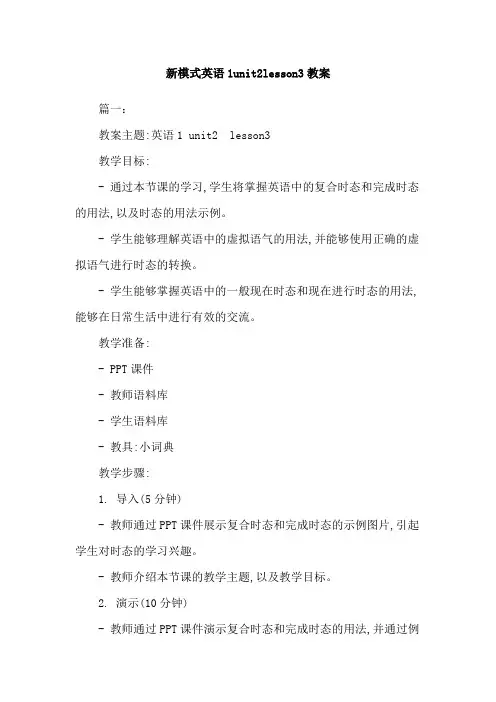
新模式英语1unit2lesson3教案篇一:教案主题:英语1 unit2 lesson3教学目标:- 通过本节课的学习,学生将掌握英语中的复合时态和完成时态的用法,以及时态的用法示例。
- 学生能够理解英语中的虚拟语气的用法,并能够使用正确的虚拟语气进行时态的转换。
- 学生能够掌握英语中的一般现在时态和现在进行时态的用法,能够在日常生活中进行有效的交流。
教学准备:- PPT课件- 教师语料库- 学生语料库- 教具:小词典教学步骤:1. 导入(5分钟)- 教师通过PPT课件展示复合时态和完成时态的示例图片,引起学生对时态的学习兴趣。
- 教师介绍本节课的教学主题,以及教学目标。
2. 演示(10分钟)- 教师通过PPT课件演示复合时态和完成时态的用法,并通过例句进行解释。
- 教师可以为学生提供一些例句,让学生能够理解时态的用法。
- 教师可以通过提问和回答的形式,引导学生进行时态的练习。
3. 练习(15分钟)- 教师为学生提供一些复合时态和完成时态的练习,让学生进行练习。
- 教师可以对学生进行评分,并给予反馈。
4. 拓展(5分钟)- 教师可以通过提问和回答的形式,引导学生进行虚拟语气的学习。
- 教师可以为学生提供一些虚拟语气的例句,让学生能够理解虚拟语气的用法。
5. 总结(5分钟)- 教师通过PPT课件回顾本节课的知识点,并对学生进行总结。
- 教师可以为学生提供一些巩固练习,帮助学生巩固本节课的知识点。
教学方式:- 授课教师通过PPT课件进行授课,为学生提供例句和练习题。
- 教师可以对学生进行提问和回答的形式,引导学生进行时态的练习。
- 教师可以通过小组讨论的形式,帮助学生理解虚拟语气的用法。
教学评价:- 教师可以通过学生的作业和课堂表现,对学生的学习情况进行评估。
- 教师可以为学生提供一些反馈,帮助学生巩固本节课的知识点。
篇二:教案主题:英语1 unit2 Lesson3教学目的:本节课的目标是让学生通过阅读和听力练习,掌握英语1 unit2 lesson3中的生词和短语,并能够根据上下文理解句子的意思。
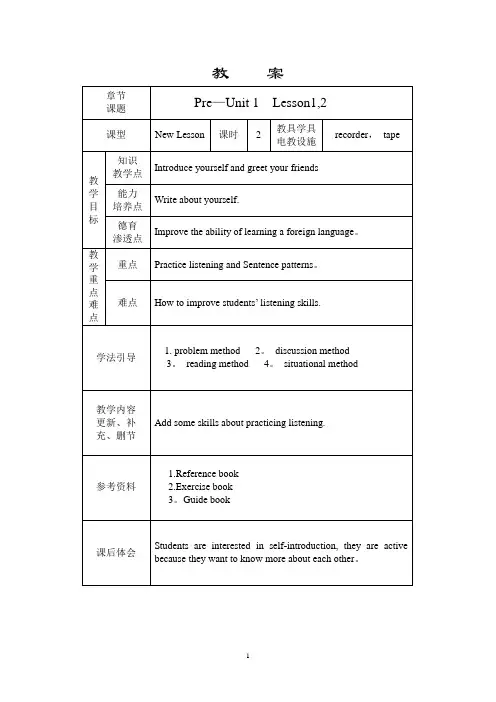
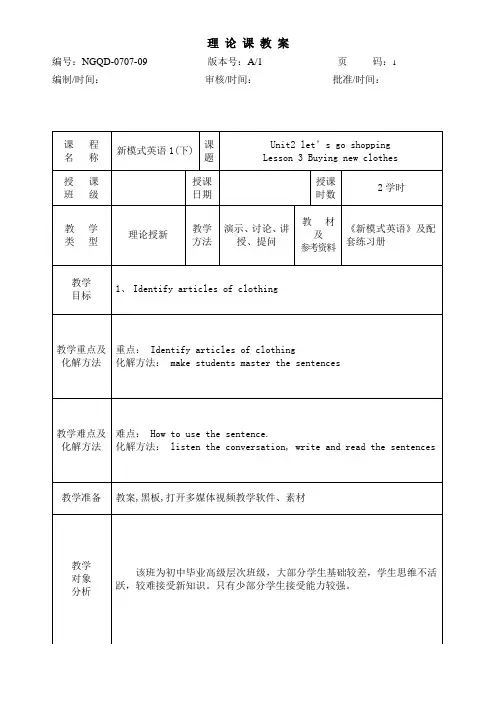
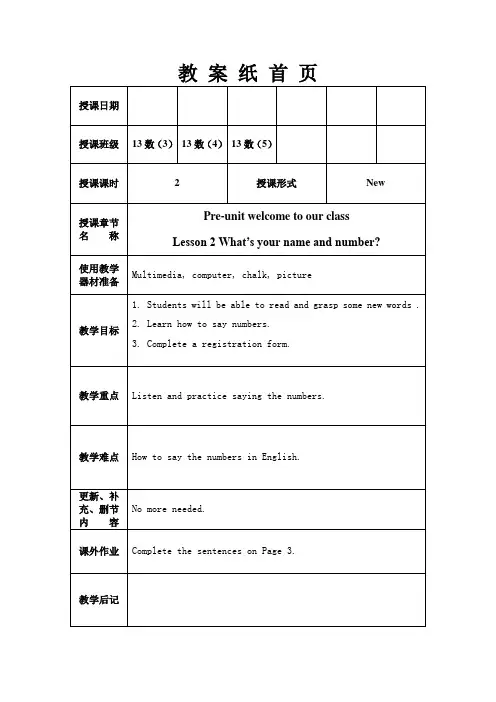
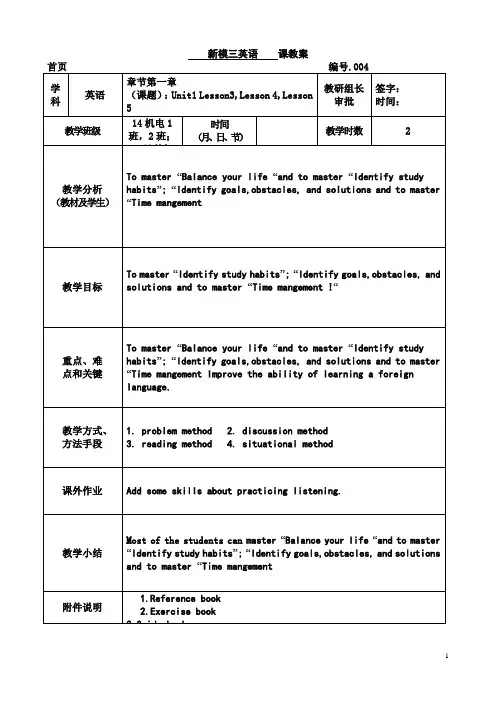
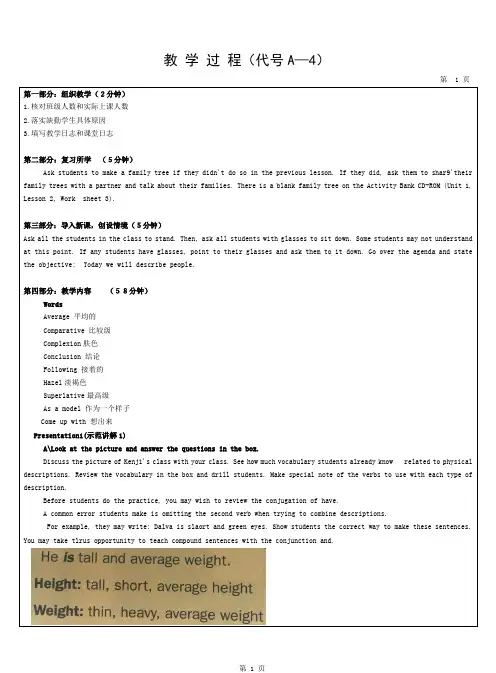
教学过程(代号A—4)第 1 页第一部分:组织教学(2分钟)1.核对班级人数和实际上课人数2.落实缺勤学生具体原因3.填写教学日志和课堂日志第二部分:复习所学(5分钟)Ask students to make a family tree if they didn't do so in the previous lesson. If they did, ask them to shar9'their family trees with a partner and talk about their families. There is a blank family tree on the Activity Bank CD-ROM (Unit 1, Lesson 2, Work sheet 3).第三部分:导入新课,创设情境(5分钟)Ask all the students in the class to stand. Then, ask all students with glasses to sit down. Some students may not understand at this point. If any students have glasses, point to their glasses and ask them to it down. Go over the agenda and state the objective: Today we will describe people.第四部分:教学内容(58分钟)WordsAverage 平均的Comparative 比较级Complexion肤色Conclusion 结论Following 接着的Hazel淡褐色Superlative最高级As a model 作为一个样子Come up with 想出来Presentation1(示范讲解1)A\Look at the picture and answer the questions in the box.Discuss the picture of Kenji's class with your class. See how much vocabulary students already know related to physical descriptions. Review the vocabulary in the box and drill students. Make special note of the verbs to use with each type of description.Before students do the practice, you may wish to review the conjugation of have.A common error students make is omitting the second verb when trying to combine descriptions.For example, they may write: Dalva is slaort and green eyes. Show students the correct way to make these sentences. You may take tlrus opportunity to teach compound sentences with the conjunction and.第 1 页Practice 1(练习1)B\Write sentences about the students in the picture. Describe their hair, eyes, height, and weight, Use the words from the boxes above.Presentation2 (示范讲解2)Read the bar graph about eye color in Kenji's class. See if students can identify who might have the different eye colors.Prepare students for focused l_istening by going over the vocabulary again for hair color, height, and weight.Practice 2(练习2)D\Look at the picture on page 7. In a group, fill in the bar graphs about Kenji's class.Presentation3 (示范讲解3)Ask three students to come to the front of the room. Ask them to line up left to right by height. Write height on the board and allow students to figure out if they should go from the tallest to the shortest or vice versa.Write tall, taller tallest and short, shorter, shortest on the board. Avoid using students to describe heavy. You may wish to interject that the word fat is not used to describe people in social situations because it can be degrading.F\Read the chart with your classmates and teacher.Provide example sentences for each of the adjectives given. Use the students in the picture n the classroom.on page 7 rather than Ss in the classroom. Write e.p on the board. Help Ss understand that the word than is necessary when using comparative adjectives. You may need to express here that your comparisons are opinions and they may not all agree.Practice 3G In a group, answer the questions about kenji’s class.Because this activity relies on opinion, groups may disagree. Try to encourage members group to compromise as necessaryso that they can prepare a report for the class.lesson 4 My schedulepractice 1Talk about their life at school. How do you spend their time in school? Let students to discuss and then share their plan第 3 页。
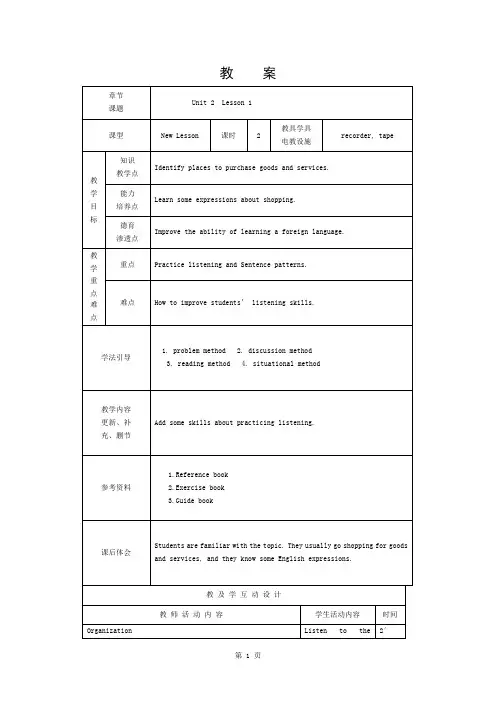
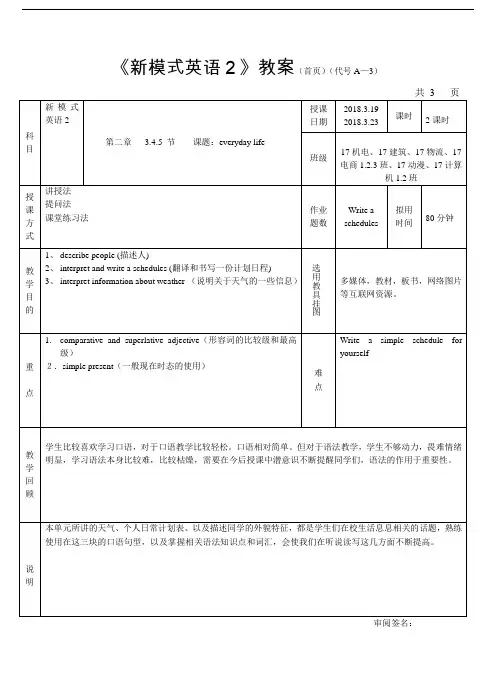
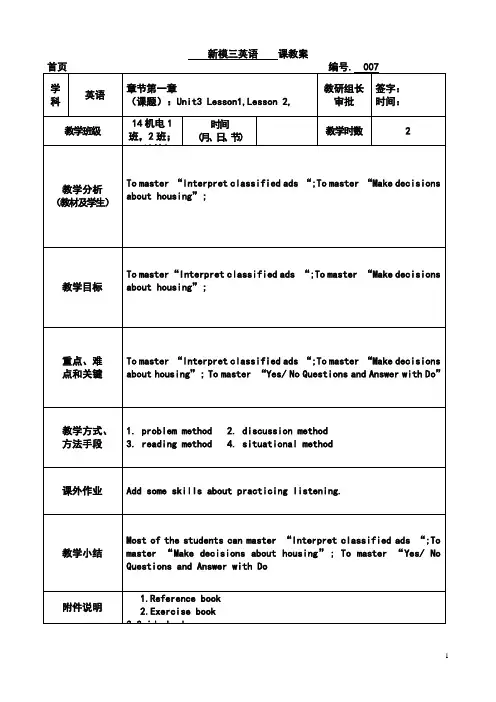
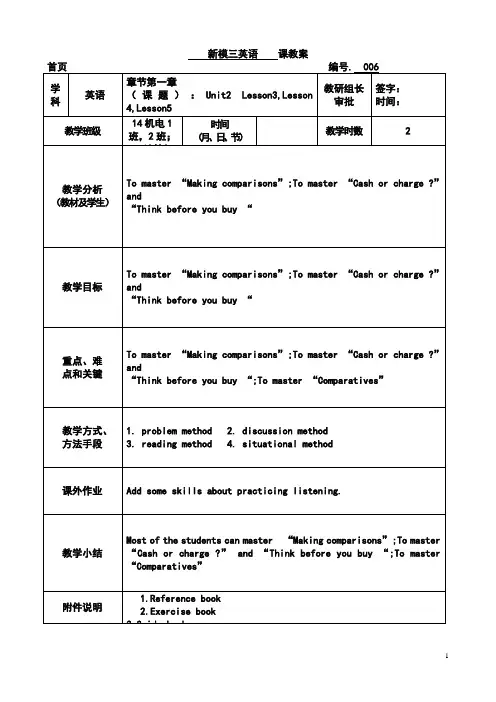
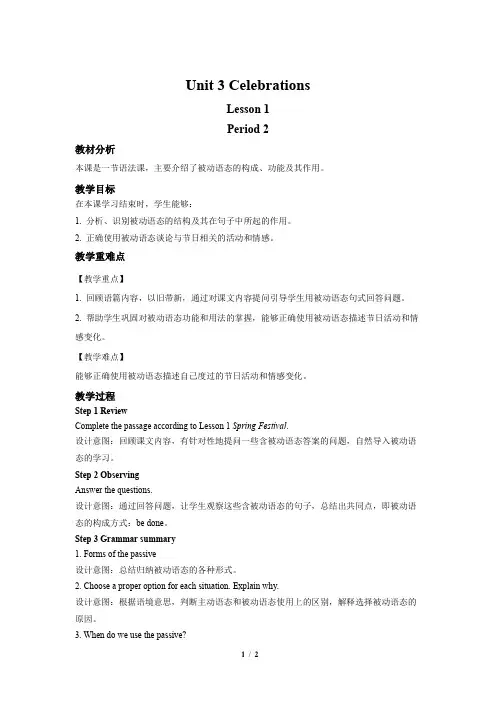
Unit 3 CelebrationsLesson 1Period 2教材分析本课是一节语法课,主要介绍了被动语态的构成、功能及其作用。
教学目标在本课学习结束时,学生能够:1. 分析、识别被动语态的结构及其在句子中所起的作用。
2. 正确使用被动语态谈论与节日相关的活动和情感。
教学重难点【教学重点】1. 回顾语篇内容,以旧带新,通过对课文内容提问引导学生用被动语态句式回答问题。
2. 帮助学生巩固对被动语态功能和用法的掌握,能够正确使用被动语态描述节日活动和情感变化。
【教学难点】能够正确使用被动语态描述自己度过的节日活动和情感变化。
教学过程Step 1 ReviewComplete the passage according to Lesson 1 Spring Festival.设计意图:回顾课文内容,有针对性地提问一些含被动语态答案的问题,自然导入被动语态的学习。
Step 2 ObservingAnswer the questions.设计意图:通过回答问题,让学生观察这些含被动语态的句子,总结出共同点,即被动语态的构成方式:be done。
Step 3 Grammar summary1. Forms of the passive设计意图:总结归纳被动语态的各种形式。
2. Choose a proper option for each situation. Explain why.设计意图:根据语境意思,判断主动语态和被动语态使用上的区别,解释选择被动语态的原因。
3. When do we use the passive?设计意图:引导学生识别在何种情况下使用被动语态,并体会其与主动语态的区别。
Step 4 Practice1. Read the news report and rewrite the underlined sections in passive voice.设计意图:在语境中把主动语态的句子改为被动语态,进一步体会被动语态在具体语境中的合理运用。
二年级上册英语教案Unit 3 lesson1《My Friends》教案人教(新起点)秋 (2)教学内容本课为《人教(新起点)秋》二年级上册英语Unit 3 lesson1《My Friends》。
本节课主要围绕认识朋友和介绍朋友展开,通过故事情境和实践活动,让学生学习如何用英语描述和介绍自己的朋友,包括朋友的姓名、外貌特征、性格特点等。
教学目标1. 知识目标:学生能够掌握本课的生词和句型,并能运用所学知识进行简单的英语介绍和交流。
2. 能力目标:学生能够通过听、说、读、写的训练,提高英语听说能力和阅读理解能力。
3. 情感目标:培养学生友好相处、乐于助人的品质,增强团队合作意识。
教学难点1. 生词的记忆和运用。
2. 句型的正确运用和口语交流。
教具学具准备1. 教师准备:多媒体课件、教学卡片、故事书、录音机等。
2. 学生准备:英语课本、练习本、彩笔等。
教学过程1. 导入:通过播放一首关于朋友的英文歌曲,激发学生的学习兴趣,引导学生进入本课的主题。
2. 新课内容学习:教师通过故事情境引入新课内容,引导学生学习生词和句型,并进行模仿跟读。
3. 实践活动:学生分组进行角色扮演,运用所学知识进行英语介绍和交流。
4. 巩固提高:教师设计一些练习题,帮助学生巩固所学知识,提高英语听说能力。
板书设计1. 课题:My Friends2. 重点生词和句型:friend、name、like、play、happy等。
3. 句型:This is my friend. His/Her name is ____. He/She likes to ____.作业设计1. 听力练习:听录音,完成练习题。
2. 口语练习:与同学一起进行角色扮演,介绍自己的朋友。
3. 写作练习:写一篇关于自己的朋友的英语短文。
课后反思本节课通过故事情境和实践活动,让学生在轻松愉快的氛围中学习英语,提高了学生的学习兴趣和积极性。
在教学过程中,教师应注重学生的个体差异,关注学生的学习进度,及时给予指导和帮助。
新模式英语教案唐义均技工院校公共课全文共3篇示例,供读者参考篇1Title: A New Model English Teaching Plan for Vocational Schools by Tang YijunIntroduction:In recent years, vocational schools have gained more attention due to the increasing demand for skilled workers in various industries. To meet the needs of the changing workforce, Tang Yijun, a renowned educator, has developed a new model English teaching plan for vocational schools. This innovative approach aims to improve students' language proficiency and equip them with the necessary communication skills to succeed in their chosen field.The Importance of English in Vocational Education:English is considered the lingua franca of the world, and proficiency in this language is essential for success in the globalized economy. In vocational education, English plays a crucial role in providing students with the necessary skills to communicate effectively with colleagues, customers, andbusiness partners. However, traditional English teaching methods may not always align with the specific needs of vocational school students, who often require practical andjob-focused language training.The New Model English Teaching Plan:Tang Yijun's new model English teaching plan takes into account the unique characteristics of vocational school education and the specific language needs of students. The plan focuses on the following key components:1. Job-Focused Curriculum:The English curriculum is tailored to the specific needs of different vocational specialties, such as automotive, construction, and hospitality. Students learn industry-specific vocabulary, communication skills, and job-related tasks to prepare them for the workplace.2. Interactive Learning Activities:The teaching plan includes a variety of interactive learning activities, such as role-playing, group discussions, and real-world simulations. These activities help students practice their language skills in a practical and engaging way.3. Technology Integration:Technology is integrated into the teaching plan to enhance students' learning experience. Online resources, multimedia tools, and interactive software are used to supplement traditional teaching methods and provide students with additional opportunities for language practice.4. Real-World Application:The plan emphasizes real-world application of English language skills by incorporating field trips, internships, and industry projects into the curriculum. This hands-on approach allows students to apply their language knowledge in authentic workplace settings and gain valuable experience.Benefits of the New Model English Teaching Plan:The new model English teaching plan by Tang Yijun offers several benefits for vocational school students:1. Improved Communication Skills:Students develop better communication skills in English, enabling them to interact confidently with colleagues and clients in the workplace.2. Enhanced Employability:By gaining industry-specific language skills and practical experience, students increase their chances of securing employment in their chosen field.3. Greater Confidence:The interactive and practical nature of the teaching plan helps students build confidence in using English in various situations, both in and outside the classroom.Conclusion:Tang Yijun's new model English teaching plan for vocational schools is a valuable resource for educators seeking to improve students' language proficiency and prepare them for success in the workforce. By incorporating job-focused curriculum, interactive learning activities, technology integration, andreal-world application, this innovative approach provides students with the necessary tools to excel in their chosen field.篇2New Model English Lesson Plan for Tang Yijun Vocational CollegeIntroductionIn recent years, vocational colleges in China have been undergoing significant changes in response to the demand for more skilled and specialized workers in various industries. As part of this transformation, Tang Yijun Vocational College has introduced a new model English curriculum that focuses on public courses. This lesson plan aims to provide a comprehensive guide for teachers at Tang Yijun Vocational College on how to effectively implement the new model English curriculum in their classrooms.Unit OverviewTitle: Public Courses in English for Vocational College StudentsGrade Level: Third YearUnit Duration: 10 weeksThemes: Communication in the Workplace, Career Development, GlobalizationSkills: Reading, Writing, Speaking, ListeningObjectives:- To improve students' English language proficiency in a vocational context.- To enhance students' communication skills for the workplace.- To increase students' awareness of global issues and cultural diversity.Lesson 1: Introducing the New Model English CurriculumObjective: To introduce students to the structure of the new model English curriculum and its objectives.Activities:1. Icebreaker: Have students introduce themselves and share their expectations for the course.2. Presentation: Provide an overview of the unit themes and learning outcomes.3. Class Discussion: Encourage students to discuss the importance of English proficiency in their future careers.Lesson 2: Communication Skills for the WorkplaceObjective: To develop students' communication skills for the workplace.Activities:1. Role Play: Divide students into pairs and assign them different workplace scenarios to act out.2. Business Writing: Teach students how to write professional emails and reports.3. Group Discussion: Discuss the importance of effective communication in the workplace.Lesson 3: Career DevelopmentObjective: To help students plan their career development using English.Activities:1. Career Path Assessment: Have students assess their strengths and interests to determine potential career paths.2. Resume Writing: Teach students how to create a compelling resume in English.3. Mock Interview: Conduct mock job interviews to prepare students for real-world interviews.Lesson 4: Globalization and Cultural DiversityObjective: To increase students' awareness of global issues and cultural diversity.Activities:1. Guest Speaker: Invite a guest speaker to talk about globalization and its impact on the workforce.2. Cross-Cultural Communication: Teach students how to navigate cultural differences in a globalized world.3. Research Project: Assign students a research project on a global issue and have them present their findings in English.Assessment- Weekly quizzes to assess students' comprehension and retention of course material.- Midterm and final exams to evaluate students' overall performance in the unit.- Group projects and presentations to assess students' collaborative and communication skills.ConclusionThe new model English curriculum at Tang Yijun Vocational College provides students with the necessary skills and knowledge to succeed in a competitive global workforce. By focusing on public courses that emphasize communication, career development, and cultural diversity, students can developa well-rounded understanding of English in a vocational context. With proper implementation of this lesson plan, teachers can help students achieve their academic and professional goals.篇3Title: New Model English Lesson Plan for Tang Yijun Technical Vocational SchoolsIntroductionIn recent years, there has been a growing demand for English education in technical vocational schools to better prepare students for the global job market. Tang Yijun Technical Vocational Schools have recognized this need and have implemented a new model English lesson plan to enhance students' language skills and communication abilities. This lesson plan aims to provide students with practical language skills that they can apply in their future careers.Lesson Objectives1. To improve students' English language proficiency in speaking, listening, reading, and writing.2. To develop students' vocabulary and grammar skills.3. To enhance students' communication abilities in both formal and informal settings.4. To introduce students to industry-specific English terminology and communication styles.Lesson Structure1. Warm-up (10 minutes)- Start the lesson with a short conversation activity to engage students and get them ready for the lesson.- Introduce a topic related to the students' field of study to spark their interest and facilitate discussion.2. Vocabulary and Grammar (20 minutes)- Introduce new vocabulary related to the topic and provide examples of how to use the words in context.- Review grammar rules and structures that are relevant to the topic.- Engage students in interactive exercises to practice using the new vocabulary and grammar concepts.3. Reading and Listening Comprehension (30 minutes)- Present a reading passage or audio clip related to the topic for students to read or listen to.- Discuss the main ideas and key points of the passage or clip as a class.- Have students work in pairs or small groups to answer comprehension questions and discuss their responses with the class.4. Speaking and Writing Activities (40 minutes)- Conduct role-playing activities where students practice using the new vocabulary and grammar in simulated real-life scenarios.- Assign writing tasks that require students to compose emails, reports, or other documents related to the topic.- Provide feedback on students' speaking and writing skills to help them improve their communication abilities.5. Wrap-up (10 minutes)- Review the key points covered in the lesson and encourage students to ask any remaining questions.- Assign homework that reinforces the lesson materials and encourages students to continue practicing their English skills outside of the classroom.ConclusionBy implementing this new model English lesson plan, Tang Yijun Technical Vocational Schools are equipping their students with the language skills and communication abilities needed to succeed in the global job market. This comprehensive approach to English education will help students build confidence in using English in professional settings and enhance their career prospects.。
预备级M 2教学设计Module 2 My English lesson Unit 3 I’m twelve.教材分析本模块的主题为“英语课堂”,属于预备级的第二模块,以“英语课”为中心,让学生在真实语境中复习或学习日常用语及简单对话,继续为学生顺利开始初中阶段的英语学习打下基础。
第三单元主要呈现了数字11至20的英文表达,要求能够运用在询问年龄的对话中。
教学目标1. 语言知识目标:1) 重点词汇:old, twelve, eleven, thirteen, fourteen, f ifteen, sixteen, seventeen, eighteen, nineteen, twenty, boy, girl, desk, chair, bag2) 重点句型:--- How old are you? --- I’m twelve.---How many boys are there? --- 15.2. 语言技能目标:1) 学习英文数字11—202) 能听懂询问年龄的对话3. 学习策略:1) 在进行口语练习的过程中创造与同学交流的机会2) 在小组合作的氛围中互相学习,互相帮助4. 文化意识:通过与人交流了解西方询问年龄的恰当方式5. 情感态度:培养人际交往的得体性教学重点与难点重点:学习英文数字11—20难点:运用英文数字11—20来表达年龄和进行加法计算教学辅助电脑,投影仪,白板教学策略基于学生的学习水平和认知特点,采用启发式教学、互动式教学的策略教学内容教学活动设计意图教师活动学生活动步骤 1热身及新课导入(5 分钟)1. 热身活动1练习英语绕口令。
2. 新课导入1老师说:Welcome to our class. Let’s greet eachother. Hello! What’s your name? How old areyou?引出本单元的标题,让学生就着标题填空。
I’m _______3. 热身活动2以操练的形式复习上一单元学过的课堂指令。